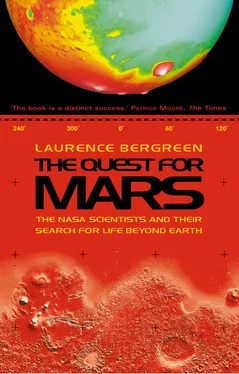Even if it landed safely, Pathfinder wouldn’t sit still on the surface of Mars, taking measurements, as the Viking landers had. It would carry a rover designed to roam across the surface, functioning as a twelve-inch-tall geologist. This was not a new idea; for decades, NASA had explored the possibility of sending a rover to investigate Mars. “My most persistent emotion in working with the Viking lander pictures was frustration at our immobility,” Carl Sagan recalled in 1980. “I found myself unconsciously urging the spacecraft at least to stand on its tiptoes, as if this laboratory, designed for immobility, were perversely refusing to manage even a little hop. How we longed to poke that dune with the sample arm, look for life beneath the rock, see if that distant ridge was a crater rampart … I know a hundred places on Mars which are far more interesting than our landing sites. The ideal tool is a roving vehicle carrying on advanced experiments, particularly in imaging, chemistry and biology.” He outlined, with his usual visionary fervor, a rover-based mission very much like Pathfinder. “It is within our capability to land a rover on Mars that could scan its surroundings, see the most interesting place in its field of view and, by the same time tomorrow, be there … Public interest in such a mission would be sizable. Every day a set of new vistas would arrive on our home television screens. We could trace the route, ponder the findings, suggest new destinations … A billion people could participate in the exploration of another world.” At the time he wrote those words, they sounded like the vaguest hyperbole, but Pathfinder and the Internet would make his outlandish prediction a reality.
Although a rover seemed like a nifty idea, it was untried. The later flights in the Apollo program had taken along a dune buggy to traverse the powdery surface of the moon. The astronauts could steer and stop the rickety lunar flivver at will. The difficulties involved in guiding Pathfinder’s rover across the surface of Mars by remote control seemed insurmountable. What if the rover didn’t emerge from the beach ball after all that bouncing? What if it got stuck on a rock or a crevice or sank into the talcum-powder-fine Martian soil? What if the beach ball landed in inhospitable terrain? What if it landed on the wrong part of Mars, where it couldn’t receive signals from Earth? And yet, if it avoided all these pitfalls and worked, the rover would provide a whole new paradigm for exploring the surface of Mars, because JPL had visions of building bigger and better rovers in years to come, until they reached the size of small trucks. But most people guessed a small rover would never work, not with the two million dollars allotted for its development.
A debate sprang up over the best way to control the rover, and, given the personalities involved, it quickly escalated into a dispute over technological theology. Tony Spear, a veteran engineer at JPL, believed the most reliable and cheapest way was to tether it to the mother ship. The other approach, advocated by Donna Shirley, was to control the rover remotely, but that meant designing or finding a new radio system, one that could tolerate the extreme fluctuations in the Martian environment, including fluctuations in temperature between the rover and the lander.
Donna Shirley was a controversial figure around JPL. When her name was announced as the Pathfinder mission director, a few cheers went up, but only a few; there was also consternation. Tony Spear, the Pathfinder project manager, was nowhere to be seen during the announcement, and Donna took his absence to indicate his lack of support. She could live with that. She thought the apparent indifference had to do with the fact that she was a woman, but she was accustomed to handling that problem. Donna had been with JPL since 1966, when very few women filled responsible posts there; during her years there, she married, raised a daughter, and got a divorce. At work, she was relentlessly cheerful, almost, but not quite, to the point of bullying, and she was a world-class talker. Many bureaucrats and scientists at NASA were camera shy, but when a television crew appeared at JPL, there was Donna Shirley in her bright red dress, flashing her assertive smile, prepared to discuss in her folksy Oklahoma twang just about anything. Her appearance was perfect for television. TV producers were delighted to interview the ebullient Donna Shirley instead of a pale male attired in the gray suit, gold-rimmed glasses, and neat mustache favored by the upper echelons at NASA. But, while being interviewed, she occasionally appeared to take credit for the work of a great many NASA scientists and engineers toiling anonymously, and that did not work to her advantage.
Her detractors said she really didn’t know her science well, but she made her lack of expertise into an asset because she had no scientific agenda, nothing to prove. She was content to bang heads together cheerfully and say, “Look, guys, now we are going to do it this way.” To the increasing number of women coming out of graduate school to work for NASA, she became a symbol. These younger women liked to tell a story about the time Donna Shirley attended a launch party at Cape Canaveral. As usual in those days, she was the only woman present. A guitarist singing a bawdy song, accompanying himself on the guitar, stopped dead when he saw her. She took his guitar and completed the song herself, delighting everyone. That was great, as far things went, but she didn’t realize there was a tradition at these launch parties that a woman – a hooker, basically – was paid to show up and pull a stunt like that. One of the men assumed Donna had been hired for the occasion, maneuvered her into an alcove, and grabbed her. “I didn’t exactly deck him,” she said, “I just hit him on the nose.”
Working on Pathfinder, she saw her team of engineers and scientists as a large family, her family. To her credit, she encouraged everyone to talk to everyone else, if only in self-defense, and she always smiled and radiated optimism. Most found it impossible to bear a grudge for long in the face of such cheerfulness; it was too exhausting to oppose her. Still, she wanted her radio-controlled rover for Pathfinder, and Tony Spear, the project manager, did not. “In his position, I wouldn’t either,” she said, “because he had the impossible job of landing on Mars for a fraction of what it cost the last time we landed. He had no idea how to do it, and here’s this parasite coming along, giving him nothing but trouble. What I did was to convince the scientists that we really could do useful work with the rover. That was number one. Number two was to convince Tony that we really could fly without damaging his mission.” When Donna presented her case to NASA’s review board, one member, Jim Martin, the former Viking project manager, insisted a Mars landing could not cost less than Viking had. As for the rover, “he thought it was terrible.” Donna and the rover team persisted, building better iterations of the rover and demonstrating they worked as advertised. “It became a very powerful selling tool,” she realized, and eventually, to everyone’s surprise, it turned into the mission’s raison d’être .
If Pathfinder’s engineering was, ultimately, carefully weighed, the mission’s science component tended to be rushed, improvised, an afterthought. Plenty of scientists were eager to participate in the new Mars mission, but they needed time and money to formulate, conduct, and analyze experiments. Pathfinder didn’t work that way. At the last minute, for instance NASA stuck a couple of stereographic cameras on the lander and another camera on the rover. These weren’t your standard television cameras; they used a technology known as a Charge Couple Device. The CCD reproduces light very accurately and is especially useful for spectroscopy, which reveals more than the naked eye can see by measuring which wavelengths of light are absorbed, and which reflected, from an object. They were useful, but they were not capable of sending back the sparkling, gorgeous images returned by Viking twenty years earlier. Pathfinder also carried an Alpha Proton X-ray spectrometer to detect the composition of Martian rocks, and a weather mast to measure the Martian temperature and atmospheric conditions. Every so often, Pathfinder would collect the weather mast’s data and return it to Earth, so for the first time it would be possible to obtain accurate weather reports from the surface of Mars. Everyone agreed the weather mast would be a terrific experiment, if it worked. It looked like Pathfinder had a chance to become a real mission, after all.
Читать дальше












